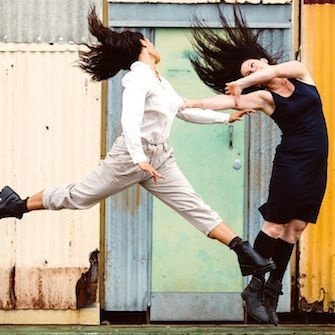AHUA
Q Theatre Loft, 305 Queen St, Auckland
08/10/2015 - 09/10/2015
Production Details
|
ew Zealand’s renowned contemporary dancers Kelly Nash and Nancy Wijohn team up with award-winning playwright and director Rachael House to devise a dance language that meditates on form, multiplicity of being, and the things we get caught up in throughout life. A unique opportunity to witness experienced dance artists with a passion for crafting and pushing cultural boundaries, Nancy and Kelly echo woman as friends or foe slipping between definitions of being Maori and being female. Ahua activates stunning imagery with exquisite kinetic timing. An Artist Talk will follow the performance on 9th October. |
Kelly Nash & Nancy Wijohn
60 mins
Refreshing reciprocity, charming co-presentation
Review by Raewyn Whyte 09th Oct 2015
Ahua, co-developed and performed by Kelly Nash and Nancy Wijohn is a refreshing, charming, almost playful, and quietly decorous portrait of themselves and particular aspects of their lives, set to a wild collage of music clips ranging from the grand processional of Beethoven’s Egmont Overture, to a cheesy 60s set; from the cheerful Drifters in Magic Moment, to the mournful vocals and theremin of Armen Ra, from smoky blues and upbeat tango to the steady pulsing of Liquid Days by Philip Glass and David Byrne.
The music sets the tone of each segment and carries resonances of personal experiences specific to a time and place. The moods are reinforced by theatrical lighting by Ruby Reihana-Wilson interwoven with abstract AV projections by Rowan Pierce — shadowy textures, oddly shaped blocks of light, black light, and occasional imagery — clouds, a window frame, the Milky Way seen close up. Primarily, though, the dancing is presented in a black box space, and the dancers mostly wear black clothing, so other than periods of brighter lighting or the gleam of flesh in the darkness, there are moments when the blackness is intensified to the point where their bodies seem to vanish altogether.
There’s a feeling of equality and reciprocity in the staging of the work, and of the time and space of the performance being equally shared. In their co-presentation there’s a generous valuing of one another, of each being proud to present the other’s best qualities to the audience.
As they move deftly through the space, their patterning implies that these two women have many parallels in their lives, having followed the same pathways, perhaps at different times, backtracking now and then or falling down and getting up to start over. There’s a strong sense of lives lived at full pace, of rushing from A to B to C and back again, frantically trying to keep track of each other, snatching moments together in passing or waving the other off to travel to some faraway place. There are times alone, flying solo, relishing solitude, trying out new things but missing the other person, and there are social occasions, public events, and quiet domestic moments to be treasured.
It’s not without gravitas — a long section has them shrouding one another completely in layers of black clothing, then slowly and very deliberately revealing very specific slivers of skin or parts of the body to which they are willing to draw attention. Here a sharply etched chin, with head titled way back and face hidden behind a cap; there a beautifully formed calf and ankle; an undulating belly, a smoothly rounded shoulder. This provides a neatly pointed commentary on the issue of how much of the dancer’s body is exposed in contemporary performance, and on whose terms that decision is made: here at least they have complete control over what they choose to reveal.
There’s a judicious balance in the timing of each segment – never too long nor too short, and you can feel the guiding hand of dramaturg Rachel House and the input of choreographic collaborators Megan Adams and Daniel Cooper in these decisions. At just 42 minutes, this first version of Ahua suggests there is great potential for expansion.
Copyright © in the review belongs to the reviewer





Comments